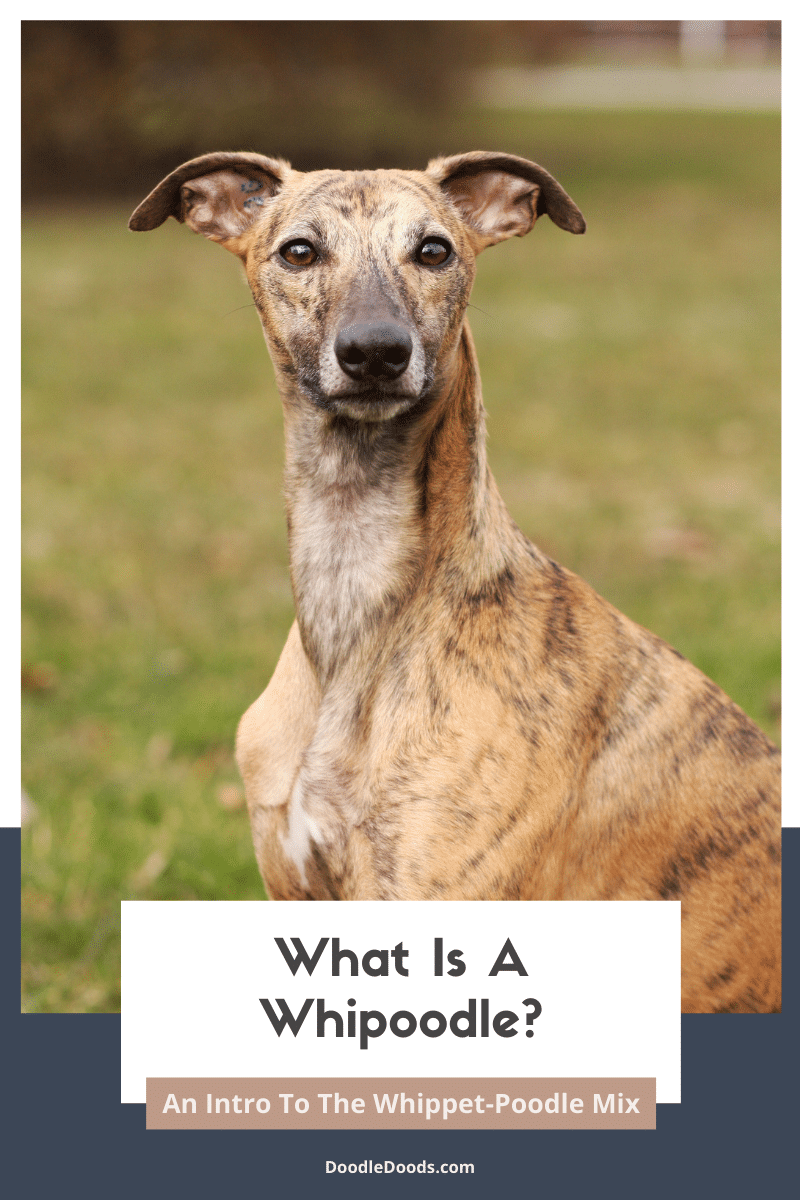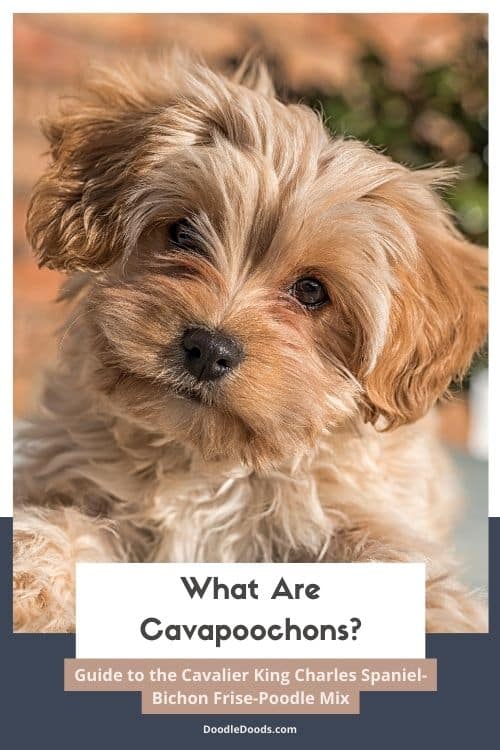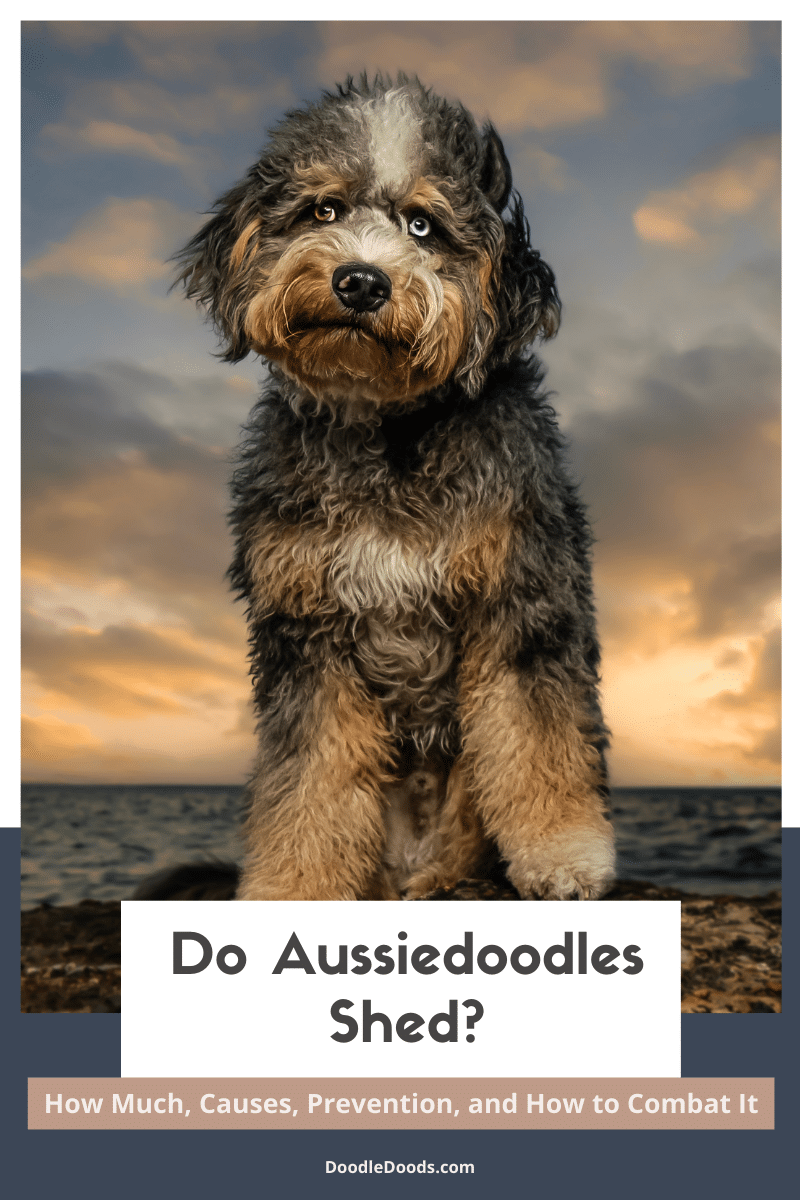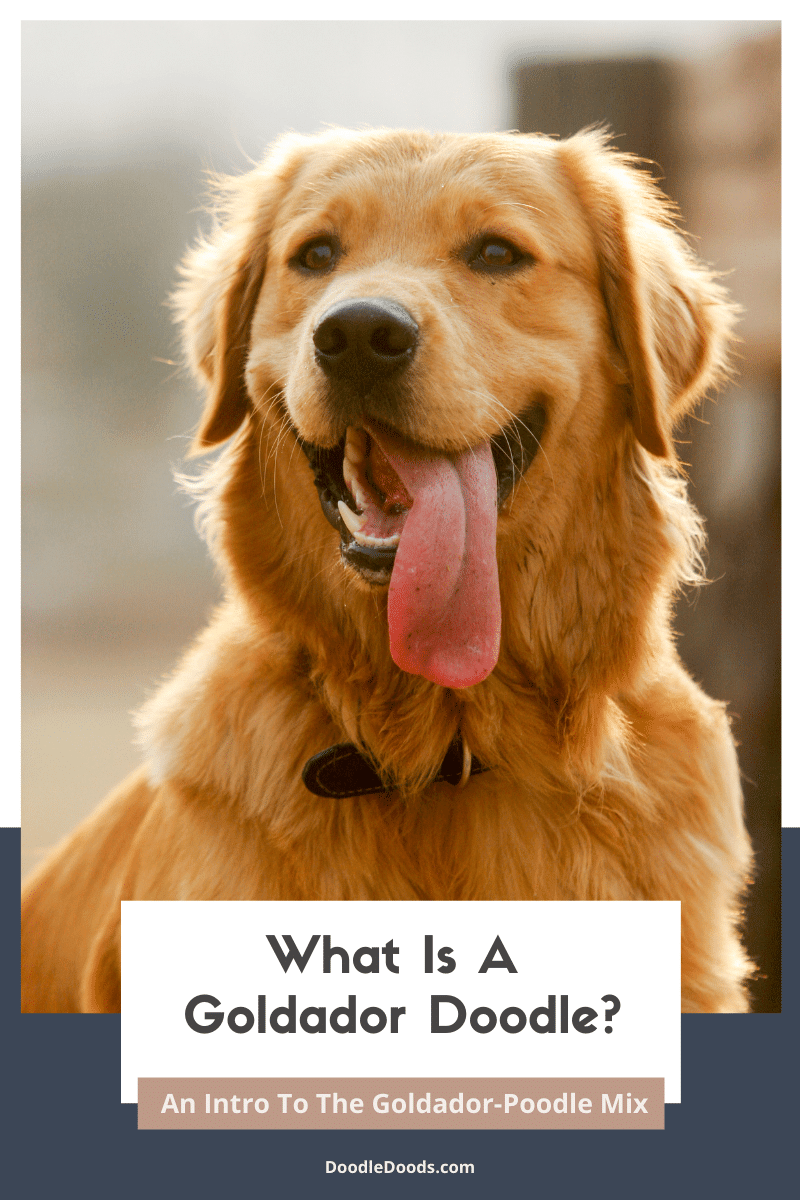The Whipoodle is a crossbreed that’s created by crossing a Whippet with a Poodle. Not much is known about the Whippet-Poodle mix by the general public, but Doodle lovers have already started to notice these precious pups alongside those well-known Poodle mixes like Cavapoos or Labradoodles. But we’re not going to keep you out of the loop any longer! So, in this guide, we’ll talk all about the Whipoodle. Whether you’d like to know how these pups look like, what their coat feels like, how much they shed, or what their personality is like, we’ve got all of this (and more!) covered.
Table of Contents
- What Is A Whipoodle?
- Whipoodle Physical Appearance
- Whipoodle Pictures (Puppy & Adult)
- Whipoodle Size: How Big Will A Whipoodle Get?
- Whipoodle Variations & Generations
- Personality & Temperament
- Whipoodle Health: Do Whipoodles Have Health Problems?
- Whipoodle Lifespan: How Long Do Whipoodles Live?
- Exercise Requirements
- Training A Whipoodle
- Coat Care & Grooming
- Where Can You Get Whipoodle Puppies?
- Whipoodle: FAQ
What Is A Whipoodle?
Whipoodle, also known as the Whipoo, is a hybrid cross between the Whippet and Poodle. The Whipoodle is generally a medium-sized pooch with a fluffy, allergy-friendly coat and a lovely, gentle, yet playful demeanor.
Both Whippets and Poodles have a long background in hunting. While Poodles are great waterfowl hunting dogs (their fun hairdos actually serve a very practical purpose for hunting), then Whippets excel at hunting small game like rabbits thanks to their insane speed. Fun fact: Whippets are thought to be the fastest dogs in their size category, reaching up to 35 MPH!
Both Poodles and Whippets are affectionate, extremely intelligent, and active breeds. They’re quite similar in many areas and the apple doesn’t fall far from the tree, either. But, of course, it’s a different story about their potential looks, grooming requirements and other considerations. So, we’ll walk you through everything you should know about the Whipoodle in the following guide.
Whipoodle Physical Appearance
Whipoodles are small to medium-sized dogs with an athletic build. They usually have long and fluffy, teddy bear looking coats that can range from curly to wavy to straight. Thanks to all of the hair on their body, you might not even notice at first how slim and athletic they actually are! Their ears are floppy, as it’s often the case with Poodle mixes.
Whipoodle Colors
Whipoodles can have any of the coat colors that are seen on purebred Whippets and Poodles. Depending on a pup’s genetic makeup, their coat colors can include black, blue, brown, fawn, red, cream, silver, and white. They may also have bi-color and tri-color coats combining all of these numerous tones. Or, some beautiful coat patterns like sable, brindle, or phantom. It’s very common for a Whipoodle to have different colors on its chest, face, and paws. Since both Poodles and Whippets come in many different coat colors, the coat colors of a Whipoodle’s parents usually is the best indicator of the potential outcome.
Coat, Shedding, & Hypoallergenic Level
Whipoodles have dense coats that can grow very long and can also vary in texture. A Whipoodle pup may inherit either a curly, wavy, or straight coat from its parents, depending on which genes are more dominant. Unlike purebred Whippets, Whipoodles have the signature Doodle coats that are long, shaggy, and fluffy. There’s no short, sleek hair on a Whipoodle, that’s for sure!
A Whipoodle’s coat is often regarded as hypoallergenic thanks to the Poodle genes in the mix. Poodles are notoriously allergy-friendly dogs with their curly coats that trap in loose dog hair, preventing it from shedding out of the coat. Not only that, Poodles are also single-coated dogs, which means that they don’t have a shedding undercoat, either.
The good news is that the Whippet is also a single-coated breed. This means that you won’t have to worry about a Whipoodle pup inheriting a double coat from its other purebred parent. If the other parent is a double-coated breed, their Doodle offspring may sometimes inherit a shedding undercoat as well.
Nonetheless, straight-coated Whipoodles may be a little bit less allergy-friendly than curly-coated Whipoodles. As we mentioned, the texture of a curly coat easily traps in any dead hair that would otherwise fall out of the coat. Speaking of which, a Whipoodle with a curly coat will most likely require a lot more grooming than wavy or straight-coated Doods due to their hair being so textured and tangle-prone.
Meanwhile, since wavy and straight-coated Whipoodles don’t get as easily tangled, they’re often easier to groom. Still, regular grooming is vital for all Whipoodles to prevent matting and shedding, regardless of their coat type.
Whipoodle Pictures (Puppy & Adult)
So, what do we get when we combine the sleek-haired Whippet and the fluffy, curly Poodle? Have a look for yourself! They’re so adorable, we simply cannot:
| Black Whipoodle | @arthur_littlelurcher |
| Gray Whipoodle | @tuffy.doggy |
Whipoodle Size: How Big Will A Whipoodle Get?
Whipoodles are small to medium-sized dogs with their weight ranging between 15 and 45 pounds and their height ranging between 12 and 24 inches when measured from the shoulder. The size of a Whipoodle will depend on the size of its parents. Most notably, which size of Poodle is used in the mix. Today, Whipoodles are most often bred with Standard or Miniature Poodles. However, in the future we can also expect to see Toy Poodles added into the mix, resulting in much smaller Toy Whipoodles.
| Mini Whipoodle | Standard Whipoodle | |
| Weight | 15-25 pounds | 25-45 pounds |
| Height* | 12-18 inches | 18-24 inches |
| When Full-Grown? | 11-13 months | 11-13 months |
*A dog’s height is measured from its withers – the highest part of its shoulder blades.
Larger Standard Whipoodles are usually created with a smaller-sized Standard Poodle or a Moyen Poodle. A Standard Whipoodle will weigh in the range of 25 to 45 pounds and have a height of around 18 to 24 inches.
The smaller variation of the Whipoodle, a.k.a the Mini Whipoodle is created with a Miniature Poodle. For better predictability and to achieve more consistency in the litters, reputable breeders will either breed a smaller purebred Whippet with a Miniature Poodle or breed a litter of Mini Whipoodles by backcrossing a smaller Whipoodle back to a Miniature Poodle.
Whipoodle Variations & Generations
With Doodle breeds, there’s a possibility to breed litters in multiple ways. A breeder could cross a purebred Whippet with a purebred Poodle, resulting in a rough 50-50 mix of both purebreds. As a result, the outcome may be slightly harder to predict. Some puppies may resemble more of the Poodle, others may inherit more characteristics of the Whippet, and some may fall somewhere in between.
But that’s not the only way to produce the Whippet-Poodle mix. There are also backcross generations like F1b, F1bb, or F2b, or also second-generation, a.k.a F2 Whipoodles, and even Multigenerational Whipoodles. Considering that the Whipoodle is a relatively new and rare Poodle mix, you’ll likely come across first-generation Whipoodles or first-generation backcross variations.
| 1st Parent | 2nd Parent | % Whippet* | % Poodle* | |
| F1 Whipoodle (first-generation) | Whippet | Poodle | 50% | 50% |
| F1B Whipoodle (first-generation backcross) | F1 Whipoodle | Poodle | 25% | 75% |
| F1BB Whipoodle (first-generation backcross backcross) | F1B Whipoodle | Poodle | 12.5% | 87.5% |
| F2 Whipoodle (second-generation) | F1 Whipoodle | F1 Whipoodle | 50% | 50% |
| F2B Whipoodle (second-generation backcross) | F1 Whipoodle | F1B Whipoodle | 37.5% | 62.5% |
| F2B Whipoodle (alternate cross) | F2 Whipoodle | Poodle | 25% | 75% |
| F3 / Multigen Whipoodle | F1B Whipoodle or higher | F1B Whipoodle or higher | Varies | Varies |
*These are generic calculations only – genetics are rarely mathematically accurate.

With each consecutive Whipoodle generation, we can predict the traits of the puppies a bit better. As you can see from the chart above, backcross generations usually have a higher percentage of Poodle in their genetic makeup. Therefore, they’ll likely inherit more traits from the Poodle’s side of the lineage as well. On the other hand, a Doodle’s generation will only tell us so much. At the end of the day, it all boils down to each puppy’s unique genetic makeup.
Personality & Temperament
Whipoodles are active and energetic dogs, but at the same time wildly loving and gentle. They adore their humans above all else and they’ll gladly cuddle up on the couch with their beloved family members. Especially after they’ve had a long day of fun activities both indoors and outdoors. If you’re worried about whether or not a Whipoodle is aggressive, then don’t worry. Whipoos don’t have a single aggressive bone in their body.
But even though Whipoodles are generally very well-mannered and friendly dogs, they do need to be properly socialized from a young age to prevent fear, anxiety, and aggression later in life. Early socialization helps your new pup to understand that there’s no need to worry in new situations, surroundings, or when meeting new people or dogs.
Whipoodles are also highly intelligent dogs. After all, the Poodle is often regarded as one of the world’s smartest dog breeds! On the other hand, they may also be quite self-willed, so you’ve got to be patient with your new best pal.
Moreover, Whipoodles are very loyal to their owners and they can also get quite protective of their home and family. They aren’t the biggest barkers out there and can certainly thrive very well in an apartment setting without disturbing the neighbors. However, they do have the tendency to alert whenever they feel the need to protect their loved ones.
Whipoodles can also often suffer from separation anxiety, as they don’t enjoy being alone for too long. They form strong bonds with their family members, so having to spend long hours away from them can make them feel stressed out and anxious.
Whipoodle Health: Do Whipoodles Have Health Problems?
The most common health issues in Whipoodles are joint problems, including hip and elbow dysplasia, as well as patellar luxation. They’re also at risk of a life-threatening condition called gastric dilatation volvulus (GDV), also known as bloat, that’s a concern for both Poodles and Whippets. Whipoodles may also suffer from eye diseases like progressive retinal atrophy (PRA) and cataracts. They’re also at risk of a heart condition called mitral valve disease (MVD), epilepsy, Addison’s disease, and thyroid issues. As purebred Whippets are prone to deafness, this is another potential issue to keep in mind.
If you’re planning to adopt a Whipoodle puppy from a breeder, be sure to only consider getting a puppy from a reputable breeding program that follows ethical breeding practices. Reputable breeders will extensively test their breeding dogs for most of the more serious Whipoodle health conditions to minimize the risks.
There are also some less serious health concerns that Whipoodles often struggle with, such as food allergies and sensitivities, as well as skin issues. They may develop allergies or sensitivities to certain ingredients in their food or grooming products. If that happens, you can easily manage those sensitivities by switching out their usual kibble or dog shampoo.
Due to their big, floppy ears, Whipoodles are also prone to ear infections. Ear infections usually develop due to improper grooming and hygiene habits. To prevent them, be sure to regularly clean your dog’s ears and gently dry them after each wash and swim.
Whipoodle Lifespan: How Long Do Whipoodles Live?
Although there are some health conditions that Whipoodles may inherit from either side of their lineage, they’re usually healthy dogs with an average lifespan of around 12 to 18 years. Like other hybrid breeds, Whipoodles are often thought to be healthier than their purebred parents thanks to something called hybrid vigor. As they inherit a more diverse genetic makeup from their parents, they’re also less likely to suffer from breed-specific illnesses.
You can do a few simple things in your dog’s daily routine to keep your Whipoo pup healthy and happy for a long time. You should feed your pup a high-quality, nutritionally balanced diet that’s suitable for their current life stage. So, for a puppy, look for a puppy formula, for an adult, an adult formula, and for an elderly dog, look into senior formulas. The amount of food will depend on your pup’s size and age, you’ll find a good guide on this topic here. In addition to that, you should prioritize your pup’s daily exercise so that they can keep their active body moving and at a healthy weight.
We also strongly recommend you keep up with your Whipoo’s yearly vet visits so that any underlying health conditions can be ruled out or discovered early on. You should also have your puppy fully vaccinated according to your vet’s recommendations and have booster vaccines administered later on.
Exercise Requirements
Like Poodles and Whippets, Whipoodles are athletic and high energy dogs that require a good amount of exercise each day to stay healthy and out of trouble. You should aim to exercise a Whipoodle at least an hour per day, if not more than that. If you notice your pup getting bored and starting to act out, it’s a good indicator that you should exercise them more during the day.
You should walk your Whipoo twice a day, but also schedule in some more vigorous playtime outdoors in a dog park or in a fenced backyard. These Doods often get the zoomies, which is completely normal for such a high energy breed. Let your pup run and enjoy itself!
While Whipoodles are calm and gentle dogs, they only tend to behave well when they’re properly exercised on a daily basis. So, your goal is to prevent that boredom as much as possible.
That being said, it’s just as important to provide plenty of mental stimulation for a Whipoo. They’re intelligent and active dogs, which means that if they don’t get enough physical or mental stimulation, they’ll resort to rebelling in various ways, but mostly destructive behaviors. Obedience training sessions and also interactive toys and puzzle games will all keep your pup’s brain busy and entertained. You should also get your pup lots and lots of chew toys to play with.
Training A Whipoodle
Thanks to the Whipoodle’s high intelligence, this Dood is usually relatively easy to train. Although they might be stubborn from time to time, they respond well to positive reinforcement and pick up new tricks and cues easily. The key is to stay consistent and patient so that your dog understands what’s expected of them. Also, don’t forget to reward your dog with praise and treats when they accomplish a task or behave well.
The easiest way to get started is to introduce your puppy to training from the moment you bring them home. Start them on a daily schedule that you follow each day, as it helps build their confidence and know when and what to expect, such as their mealtimes, potty breaks, and so forth. The sooner you start with potty training, obedience training, and crate training, the easier it will be later down the line.
It’s also important that you start introducing your new pup to people of all ages and other pets as soon as possible. This helps them learn how to properly interact with others outside of their own household and prevent fear and anxiety once they become older and are put in more new situations and surroundings. PS! Only socialize a young Whipoo puppy with fully-vaccinated dogs. Once your pup has received all of its vaccinations, you’re good to bring them outside in public places.
Online Puppy School by Baxter & Bella
If you’re looking for a good training program for your Whipoodle pup, then we recommend you give the Online Puppy School by Baxter & Bella a try. This program is completely online and you can follow each of their lessons and topics at your own pace, from the comfort of your own home. They have countless resources on basic training techniques like commands, potty training, or leash walking, and also lots of guides on how to tackle certain behavioral issues. For a one-time fee, you’ll get lifetime access to their program, which is an absolute steal in our opinion!
Coat Care & Grooming
With those long, thick coats, Whipoodles are what many would consider high-maintenance dogs. They need to be groomed regularly to prevent matting, but also to minimize shedding and reduce allergens. Even though Whipoodles are single-coated breeds that shed very minimally, this issue could emerge with improper grooming routines and due to certain health issues like allergies and sensitivities. Keep in mind that more shedding = more allergens.
Unlike purebred Whippets, Whipoodles need to be brushed regularly to prevent matting and minimize shedding. Curly-coated Whipoodles should be brushed daily with a heavy-duty slicker brush, as they’re the most prone to matting. But wavy and straight-coated pups could be brushed about 3-4 times a week if you can’t commit to doing it every single day.
In addition to daily brushing, you should also regularly bathe and groom your Dood. Since Whipoodles’ hair grows fast and long, you should have their hair trimmed every 6 to 10 weeks. A professional dog groomer can certainly help you with that. However, if you’d like to save money and build a stronger bond with your pup, then we recommend you learn how to do it yourself with the help of our How To Groom A Doodle At Home online course.
In terms of bathing, you wouldn’t want to bathe your Whipoodle too often, as this could lead to skin dryness and other potential issues. If you notice your pup getting smelly or dirty, that’s a good time to give them a thorough wash. But most of the time, these dogs can be washed at the same frequency as they’re getting their hair trimmed. Only use specially formulated dog shampoos and a dog conditioners, since human products can be harmful for dogs.
Other activities in a Whipoodle’s grooming routine include:
- Weekly nail trimming with a dog nail grinder or a dog nail clipper;
- Weekly ear cleaning with a dog ear cleaner;
- Daily (or at least a few times a week) teeth brushing with a dog-safe toothpaste and a dog toothbrush.
Where Can You Get Whipoodle Puppies?
If you’re planning to adopt a Whipoodle pup, then the first step would be to find a reputable Whipoodle breeder. Our guide How To Choose A Responsible Doodle Breeder will help you get started on this journey so that you know how to avoid puppy mills and Doodle scammers.
If you’d like to know how much does it cost to adopt a Whipoodle, then be prepared to pay around $1,500 to $5,000 for a puppy. These are the average prices when adopting from a responsible breeding program. Indeed, the prices aren’t cheap, but you’ll rest assured knowing that your new puppy comes from an extensively health screened, healthy, and strong bloodline.
Not only that, ethical breeders also do everything in their power to provide a loving and nurturing home environment for their breeding dogs and their puppies. They also introduce the puppies to potty training and basic manners, and start socializing and desensitizing them to various experiences. None of which you’ll get with a puppy mill or a backyard breeder.
If you’re not quite sure where to start looking for responsible Whipoodle breeders, then we recommend you keep an eye on our Doodle Breeder Directory where we list reputable Whipoodle breeders in the US and other countries.
Whipoodle: FAQ
Whipoodles make GREAT pets, as they’re very friendly and outgoing, affectionate, loyal, and intelligent. They’re also very allergy-friendly and low-shedding dogs, which means that these Doods are even suitable for people who have dog allergies. Thanks to their size, they can live amazing lives in both apartments and more spacious homes. Just make sure to exercise your pup daily, as these Doods are very active.
Whipoodles often aren’t inclined to bark, as Whippets are some of the quieter dogs. However, as the Poodle can be quite a vocal dog, the Whipoodle may sometimes inherit this trait. At the end of the way, it all boils down to how well a dog has been socialized and desensitized in their life. Also, if you notice that your dog can’t seem to stop barking, it could be due to them not getting enough exercise and mental stimulation.
A Whipoodle is best for someone who has the time each day to devote to their dog’s exercise and grooming requirements. Like with other Doodle breeds, Whipoodles need to be groomed to prevent matting, but also a host of other skin and coat problems. And thanks to their high energy levels, they’re best suited for active people who enjoy spending time exercising and playing with their pet. Another thing to keep in mind is that Whipoodles are often prone to separation anxiety. For this reason, they’re best suited for households where at least one person can stay at home during the day as well.
Learn How to Care for Your Doodle Puppy!

Perfect for first-time Doodle parents, get ALL your questions answered, including questions new Doodle parents don’t even think to ask.
Plus, get $700 worth of Bonus Materials for FREE, including:- Doodle Parenthood Community and Support Group ($190 value)
- Doodle Puppy Growth Tracker ($20 value)
- EMERGENCY Cheatsheet: When To Call The Vet Immediately ($50 value)
- HELP! Button ($145 value)
- And SO MUCH MORE!









